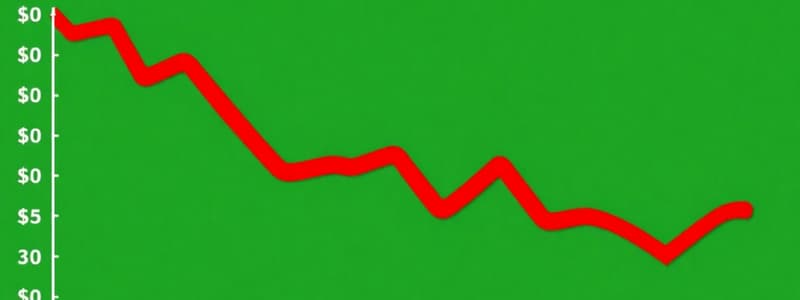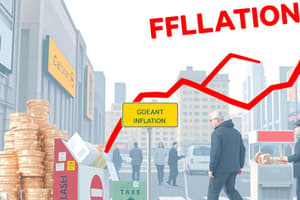Podcast
Questions and Answers
What is a demand side cause of inflation?
What is a demand side cause of inflation?
- Increase in consumer spending (correct)
- Decrease in export demand
- Rise in production costs
- Improvement in technology
Which type of inflation results from a decline in aggregate supply?
Which type of inflation results from a decline in aggregate supply?
- Demand-pull inflation
- Hyperinflation
- Built-in inflation
- Cost-push inflation (correct)
What is a quantitative measure of credit control used by central banks?
What is a quantitative measure of credit control used by central banks?
- Open market operations
- Interest rate targeting
- Cash reserve ratio (correct)
- Moral suasion
What are the main objectives of fiscal policy?
What are the main objectives of fiscal policy?
What does the IS curve represent in an economic model?
What does the IS curve represent in an economic model?
What is an example of disequilibrium in balance of payments?
What is an example of disequilibrium in balance of payments?
What shift occurs when the IS curve moves to the right?
What shift occurs when the IS curve moves to the right?
What does the slope of the LM curve indicate?
What does the slope of the LM curve indicate?
Flashcards are hidden until you start studying
Study Notes
Inflation: Causes and Types
- Demand-side causes: Increase in consumer demand, government spending, or foreign investments can lead to inflation as demand outstrips supply.
- Supply-side causes: Rising production costs, such as wages and raw materials; supply chain disruptions can result in inflation as the cost of goods increases.
- Definitions: Inflation refers to the sustained increase in the general price level of goods and services in an economy over time.
- Types of Inflation:
- Demand-pull inflation: Occurs when demand exceeds supply.
- Cost-push inflation: Triggered by increasing costs of production leading to higher prices.
- Built-in inflation: Linked to adaptive expectations, where businesses and workers expect prices to continue rising.
- Stagflation effects: Characterized by stagnant economic growth, high unemployment, and high inflation; complicates policymaking and economic recovery.
Credit Control Measures by Central Banks
- Quantitative measures: Used to control the money supply and maintain economic stability through:
- Reserve requirements: Mandating banks to hold a certain percentage of deposits as reserves.
- Open market operations: Buying or selling government securities to influence the amount of money circulating in the economy.
- Discount rate: Adjusting the interest rate at which banks can borrow from the central bank affects overall lending rates.
Fiscal Policy Objectives
- Economic stability: Aims to stabilize the economy, manage inflation, and reduce unemployment.
- Resource allocation: Ensures that resources are allocated efficiently to support economic growth.
- Income redistribution: Seeks to promote social welfare and equity through taxation and public spending programs.
Types of Public Debt
- Internal debt: Money borrowed by the government from domestic lenders through loans and securities.
- External debt: Borrowing from foreign entities, which can include loans from other countries or international organizations.
- Government bonds: Represent long-term borrowing that must be repaid with interest, a common form of public debt.
IS Curve Derivation
- IS curve: Represents equilibrium in the goods market where investment equals savings; derived from the relationship between interest rates and level of income.
- Shift factors: Changes in government spending, investment, or taxes can shift the IS curve left or right, indicating a change in equilibrium income at a given interest rate.
LM Curve Slope Discussion
- LM curve: Reflects money market equilibrium where money supply equals money demand; its slope indicates the relationship between the money supply and interest rates.
- Factors affecting slope: A steeper LM curve suggests that significant changes in interest rates are needed to change the quantity of money demanded.
Studying That Suits You
Use AI to generate personalized quizzes and flashcards to suit your learning preferences.




